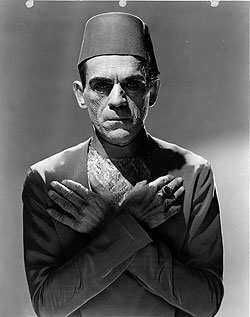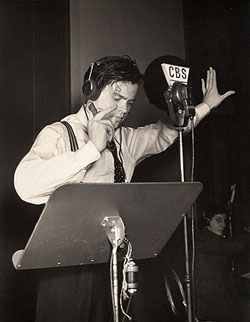The Haunter Of The Dark: Horror In Radio
Published on September 29th, 2011 in: Books, Halloween, Horror, Radio, Retrovirus, Science Fiction |By Paul Casey
“It. Is. Later. Than. You. Think. Lights Out brings you stories of the supernatural and the supernormal, dramatizing the fantasies and the mysteries of the unknown. We tell you this frankly. So if you wish to avoid the excitement and tension of these imaginative plays, we urge you, calmly, but sincerely to turn off your radio, now. And now, Lights Out, everybody.”

Boris Karloff as The Mummy
About three years ago, I discovered a website called The Monster Club, which hosted many copyright-free recordings of old, and some more recent, radio horror plays. For several months afterwards, I would take my iPod to bed, and listen to one after another of these macabre, wonderfully performed tales. Featuring such horror icons as Vincent Price and Boris Karloff, these grim tales included excellent adaptations of Edgar Allan Poe and H.P. Lovecraft stories, as well surprisingly unsettling original stories written for the radio.
Two of my favorite shows came from the 1930s and ’40s. Lights Out, mentioned above, featured a string of original, terrifying tales. With the gleefully creepy introductory warning, you enter a world of unholy experiments and sadistic violence. “Death Robbery,” starring the great Boris Karloff, is one of the best: a mad scientist tale, showing why the rejection of mortality has been such fertile ground for horror and science fiction. “A Knock At the Door” is about, as Richard Lewis would put it, the mother-in-law from Hell. Then there is the meta “Murder In the Script Department,” which presents the inexplicable death of a lowly Lights Out script writer.
It is surprising just how disturbing and vicious these stories can be. Being frightened by a show from over a half a century ago—the time of such odious censorship laws as the Hays Code—is not something we expect. The ability of these writers and performers to unsettle us is up there with the excess of Takashi Miike or Eli Roth. This is most apparent when Suspense, my other favorite horror show, deals with perhaps the greatest horror writer of all, Edgar Allan Poe.
“The Pit and the Pendulum,” a truly frightening story of a prisoner during of Spanish Inquisition, shows that the “torture porn” sub-genre is not as new or as shocking as some would like to believe. Here, Vincent Price expresses terror and the protection of madness in times of great distress in his idiosyncratic way. “The Pit and the Pendulum” shows that in horror extreme violence is often a relief from tension. Poe deals in mental anguish like only he can and proves that there is more to fear in ourselves than in a hockey-masked wielder of butcher knives and punisher of loose teenagers.

Orson Welles
Another great play from the archives of Suspense is the Orson Welles vehicle, “The Most Dangerous Game.” Written in 1924 by Richard Connell, it sees a hunter fall prey to one who hunts the most dangerous game of all: MAN! While his famous War of the Worlds adaptation—which aired on Mercury Theatre on the Air—is of course required listening, it is a wondrous thing to hear that old genius wield his talents in the horror arena. It makes one wish that Welles had taken his obvious skill in creeping terror to the big screen.
It would be foolish however, to think that the skills needed to produce these feats of pure imagination are solely the products of a bygone age. In the late 1980s, NPR produced a series of shows intended to recapture the spirit of Suspense. Tales From the Shadows adapted classic horror stories with the same skill as that earlier show. My favorite is the H.P. Lovecraft tale of genetically inherited doom, “The Rats in the Walls.” “The Rats in the Walls,” first published in 1924 in the ageless chronicle of horror, Weird Tales, centers on a man who inherits an estate in England. Insanity follows. As with “The Shadow Over Innsmouth” and much of H.P. Lovecraft’s work, the moral is: you cannot escape yourself and you probably shouldn’t even try.
In 2004, BBC Radio broadcast Christopher Lee’s Fireside Tales, which are about as comforting as you can imagine. A series of exquisitely performed horror stories by the master of Hammer Horror, the best is probably Poe’s “The Black Cat,” a sadistic tale of a man haunted by a cat who just won’t die. Friends of the furry fellow will find it a most disturbing story.
All of these radio plays, and many more, can be found on The Monster Club, which does require a quick and painless registering. It is worth the minor hassle. As you settle down on Halloween to think of a deliciously shocking way to spend your evening, do not only think on The Texas Chainsaw Massacre or the grown-man-birthing of Gozu. Turn off the lights, switch off the part of your brain which experiences conventional reality, and prepare for the evil in the hearts of men and women alike. Unfiltered, straight to your brain, horror.
Time limit is exhausted. Please reload the CAPTCHA.